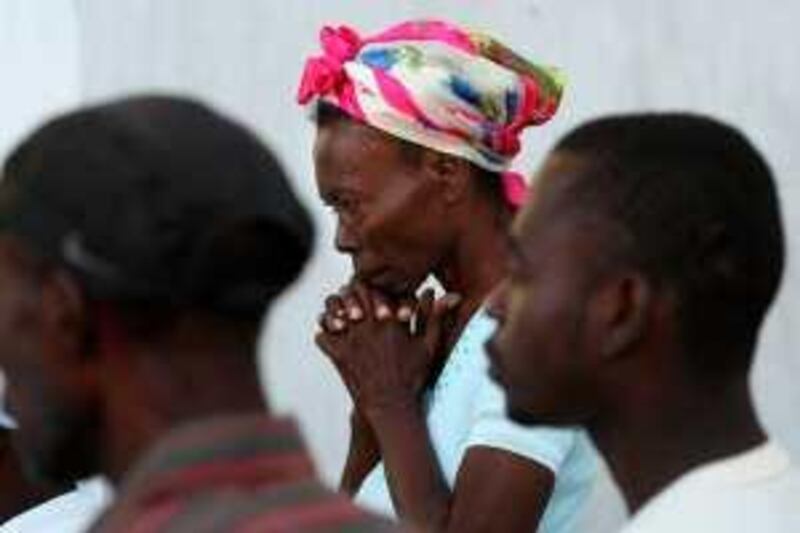PORT-AU-PRINCE // Plumes of smoke billowed from across the plains north of Haiti's earthquake-ravaged capital yesterday, as a procession of dumper trucks unloaded thousands of corpses into mass graves and ramshackle pyres. The authorities slowly kicked into action following the magnitude-7.0 earthquake that levelled one-third of Port-au-Prince's buildings, removing stacks of gangrenous bodies before they could spawn outbreaks of disease.
After unloading dozens of corpses into freshly dug pits near Titanyen, 15km north of the capital, the truck driver Joseph Mario was returning to the downtown hub to collect more crushed quake victims. "I'm picking up my family, my friends - all of my Haitian brothers and sisters," said the security guard from the ministry of public works. "We drive into the city centre and pick them up, take them here and throw them away. This is the worst part of the job."
Mr Mario, 33, who watched his girlfriend die in his arms after she was struck by falling masonry during Tuesday's tremors, expected to shift more than 1,000 cadavers during eight round trips before sunset. "I've never seen anything like this before; it will be in my head for the rest of my life," he said. "But we will keep going on and do this until there are no bodies left in the town. They have to be destroyed."
Like much of the relief efforts slowly beginning to affect this devastated city, body disposal is a haphazard exercise that lacks co-ordination and sees mounds of corpses dotted randomly across the countryside. Piles of half-burnt bodies can be found either side of the road headed north, with nearby diggers excavating squares of earth for trucks to unload a cargo of mangled bodies amid broken concrete, steel and rubble. The corpses of men, women and children lie swelling in the tropical sunlight, their skin yellowing, their bodies releasing an overpowering stench.
The UN's World Health Organisation estimated that between 40,000 and 50,000 people were killed by the earthquake. The Haitian government estimated on Friday more than 50,000 people were killed and 250,000 injured. Senior Haitian politicians have said the number could rise to 200,000. Across Port-au-Prince, the dead litter the streets, decomposing and covered in flies. The efforts of recently arrived foreign aid workers seem almost inconsequential by comparison with the scale of the devastation wrought by the quake.
"The truth is that we don't know what will be done with the dead," Joseph Tihaly, a Haitian volunteer helping identify corpses at the general hospital, told Agence France-Presse. "We don't know when these bodies will be taken, and we don't know by whom. It's chaos and a breeding ground for infection." Foreign rescue teams are spread out across the sprawling capital of three million. They take their cues from various sources: UN staff sent some to locations where survivors were believed to remain, and desperate relatives dispatched others to spots where loved ones were still missing, and voices and moaning could be heard inside.
Very few of the stories have a happy ending; most end in the discovery of a tangle of dead bodies. "The first 72 hours are so important. After that the chances just drop dramatically," said Jose Ignacio Bugella Yudice, here from the civil protection service in the Spanish city of Getafe. As quake survivors scour the body piles at the main hospital and other makeshift morgues in the city centre for their loved ones, mourners acknowledge that disposing of unidentified bodies is a medical necessity.
"If you haven't seen your brother, your sister or mother for two or three days after the quake, then you know that they are dead," said a city denizen, Noël Myford, 24. "You just feel sad for the person and know that it is finished." David Wimhurst, a spokesman for the UN's peacekeeping mission to Haiti, said the blue helmet force had built one mass grave outside the city and had three more under construction in partnership with the Red Cross.
"On the Haitian bodies in the streets, there is no identification. They're rotting in the sun and decomposing and this is extremely hazardous to public health," Mr Wimhurst said. "They're coming out in their thousands." jreinl@thenational.ae * With additional reporting by Agence France-Presse







